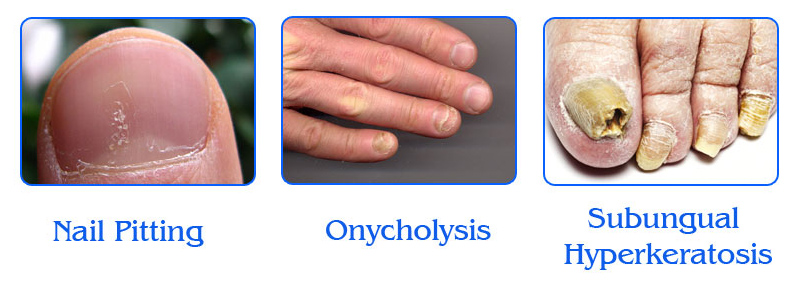Psoriasis is a skin disorder which is characterized by fiery red and dry scales on the affected skin and nail abnormalities. Psoriasis can affect toe nails or finger nails thus causing thickening, pitting and irregular contouring of the nails.Nail psoriasis occurs in patients who are suffering from symptomatic psoriasis. Less than 4-5% patients suffer from nail psoriasis with no other clinical findings of psoriasis. If nail psoriasis is not treated on time, then it can lead to social and functional impairment.
Stages of Nail Psoriasis
People suffering from nail psoriasis exhibit nail changes. The various types of nail psoriasis are:
Type 1: Classic distal interphalangeal joint involvement (5% of patients)
Type 2: Arthritis mutilans
Type 3: Symmetric polyarthritis
Type 4:Asymmetric oligoarthritis(occurs most commonly)
Type 5:Ankylosing spondylitis
Symptoms of Nail Psoriasis
These are some symptoms given below:
- Patch formation in nail bed: This is the most characteristic sign of Nail Psoriasis. There is formation of yellow-red discoloured patch in nail bed. There is translucent lesion formation.
- Pitting of nail matrix: Due to loss of keratin cells, from the upper surface of nail plate, it results in pitting formation.
- Formation of Beau lines: There is formation of transverse lines in the nails
- Onycholysis: It is defined as formation of white area due to pathological separation of nail plate from nail bed.
- Crumbling of nail plate: The disease can cause weakening of nails and underlying structures.
- Subungual hyperkeratosis: There is excessive proliferation of the nail bed lead to the condition called onycholysis.
Treatment of Nail Psoriasis
Nail psoriasis has no cure but it can be improved and can be returned to normal condition. It can cause nails to look ugly and can be uncomfortable. This can also lead to psychosocial distress.
The treatment largely depends on the severity of the disease.
- Calcipotriol solution: It is safe to use and should be applied twice in a day.
- Topical corticosteroids are recommended to be used at bed time. It gives effective results.
- Intralesional triamcinolone acetonide: The solution is injected into proximal nail folds to get desired results.
- Phototherapy: Narrow band UVB or PUVa is recommended to treat the severe cases
- Systematic treatment: Includes use of oral methotrexate, ciclosporin, retinoids to deal with psoriasis.
- Surgical treatment: Includes complete surgical removal ofnail in case of severe cases.
- Antifungal medication: If secondary infections occur then antifungal medications are also prescribed.


 (2 votes, average: 3.50 out of 5)
(2 votes, average: 3.50 out of 5)
